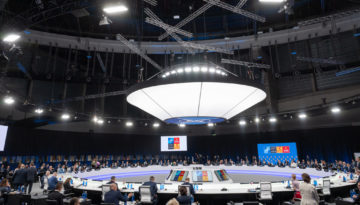
Mona Ali in The Polycrisis:
When NATO held its two-day summit in Madrid in June 2022, the Spanish government deployed ten thousand police officers to cordon off entire parts of the city, including the Prado and the Reina Sofia museums, to the public. A day before the summit began, climate activists staged a “die-in” in front of Picasso’s Guernica at the Reina Sofia, in protest against what they identified as the militarization of climate politics. That same week, the US Supreme Court had removed federal protections for abortion rights, clamped down on the US Environmental Protection Agency’s ability to curb greenhouse gas emissions, and expanded the right to carry concealed weapons in the United States. In contrast to the chaos at home, at the summit, President Joe Biden’s team projected a revivified notion of hegemonic stability.
Primarily a transatlantic military alliance, NATO represents the concentration of global power in the North Atlantic. In its self-described 360-degree approach to integrated deterrence—involving cyber-tech and “interoperability” between Allied defense systems—NATO is a twenty-first century Benthamite panopticon, under whose gaze lies the rest of the world. In the name of upholding democratic values and institutions, NATO has assigned itself the role of global crisis manager. Its extra territorial mandate now spans addressing “conflict-related sexual violence” to climate adaptation.
More here.
